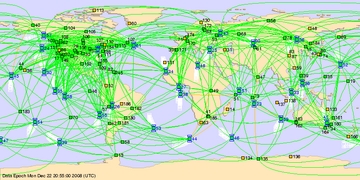 The Near Earth Network
"The Near Earth Network is comprised of tracking stations distributed throughout the world in locations including Svalbard, Norway; Kiruna, Sweden; Weilheim, Germany; Fairbanks, Alaska; Santiago, Chile; McMurdo, Antarctica; Wallops Island, Virginia; South Point, Hawaii; Dongara, Australia; Hartebeesthoek, South Africa; White Sands, New Mexico; and Merritt Island, Florida. The NEN provides Telemetry, Tracking, and Commanding (TT&C) services to an extensive and diverse customer base, which includes approximately 35 missions - from the high-rate Earth Observing System (EOS) missions such as Aqua, Aura, ICESAT, and QUIKSCAT, to Small Explorer (SMEX) missions including GALEX, SWAS, SWIFT, TIMED and TRACE. It also provides TT&C services for an average of 140 passes per day. The polar stations, Kongsberg Satellite SA (KSAT) Svalbard Ground Station (SGS) in Norway and the SSC/USN Alaska Ground Station in Fairbanks, Alaska, provide almost half of the 140 passes per day collectively.
The services provided by the Near Earth Network are primarily for flight missions over short link distances. These missions require daily and sometimes hourly periodic contacts in their orbital and suborbital locations, including Low Earth Orbit (LEO), Geosynchronous Earth Orbit (GEO), lunar, and highly elliptical orbits.
Each of the 140 TT&C supports per day is scheduled from the Data Services Management Center, located at the White Sands Complex in White Sands, New Mexico." ... more
|








 - Astronautic
- Astronautic - Astronomy
- Astronomy - Space Astronomy
- Space Astronomy

